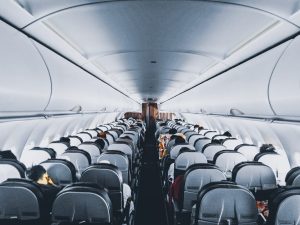DOT Proposes Rule to Improve Lavatory Access on Single-Aisle Aircraft
By PVA National Staff
The U.S. Department of Transportation (DOT) has issued a new proposed rule for public comment to improve restroom access for passengers with disabilities on single-aisle aircraft. The proposed regulation calls for limited improvements to lavatory interiors, enhanced criteria for onboard wheelchairs, and training of flight attendants. Comments on DOT’s proposal are due by March 2, 2020.
The proposed rule is intended to improve the accessibility of single-aisle aircraft with seating capacity of 125 or more seats as they are increasingly being used by airlines for long-distance flights. Specifically, it would require airlines that operate new single-aisle aircraft with seating capacity of 125 or more seats to ensure the accessibility of features within the aircraft lavatory, including but not limited to toilet seats, assist handles, faucets, attendant call buttons, and door locks.
The proposed rule also includes training and information requirements that would apply to the airlines’ operations. Airlines would be required to train flight attendants on proper procedures for providing assistance to individuals with disabilities to and from the lavatory from the aircraft seat, including hands-on training on the retrieval, assembly, stowage, and use of the aircraft’s on-board wheelchair, and training regarding the accessibility features of the lavatory. To ensure that passengers with disabilities have accurate information about the types of accessibility features available on aircraft and can plan their flight appropriately, DOT proposes to require that airlines make information concerning the accessibility of aircraft lavatories available on the airline’s website, on the aircraft, and upon request to individuals with a disability.
In addition, the proposed rule would establish improved performance standards for onboard wheelchairs, which are used to transport non-ambulatory passengers to lavatories from their seats. Under the regulation, the onboard wheelchairs would need to align with the height of airline seats for easier transfer and have wheel locks and other features for safety and stability. The chair would allow entry in a forward manner for passengers who can perform a stand-and-pivot transfer. The rule also would require the chair to be capable of completely entering the lavatory in a backward orientation and fitting over the closed toilet lid so that the door can be closed for privacy in performing non-toileting functions.
In August, the Access Board proposed voluntary guidelines for onboard wheelchairs to supplement DOT’s performance criteria. These proposed guidelines, which contain non-binding technical specifications for the dimensions, features, and capabilities of onboard wheelchairs, would provide airlines and onboard wheelchair manufacturers with an example as to how DOT’s performance criteria could be met. The Board is currently finalizing these guidelines based on the public comments it received.
Unfortunately, the proposed rule does not address the size of lavatories. Instead, DOT will issue an advance notice of proposed rule making (ANPRM) to solicit comment and gather information on the costs and benefits of requiring airlines to make lavatories on new single-aisle aircraft larger, equivalent to that currently found on twin-aisle aircraft. PVA strongly believes in the need for fully accessible lavatories in line with the agreement made during the 2016 negotiated rule making on accessible lavatories and will strongly support larger lavatories in the ANPRM.
For more on the proposed rule click here



